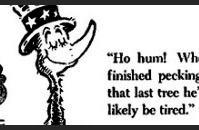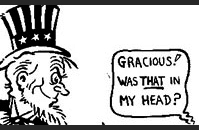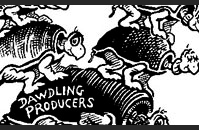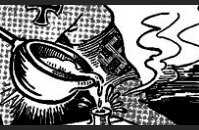LESSON PLAN:
Dr. Seuss & WWII: Analyzing Political Cartoons
Dr. Seuss is the beloved author of more than 50 children’s books. But many students do not know that he drew over 400 political cartoons during WWII. These cartoons tackled such subjects as racism and discrimination, the dangers of isolationism, fascism, and other political issues, and the vital work of the war effort at home.
Objective:
Students will analyze four WWII-era Dr. Seuss cartoons, gaining a greater understanding of the use of symbolism, caricature, stereotyping, analogy, juxtaposition, irony, and humor, as well as a deeper appreciation and perspective of issues confronting the U.S. Home Front.
Grade Level: 7-12
Standards:
History Thinking Standard 4—the student interrogates historical data by uncovering the social, political, and economic context in which it was created. Historical Thinking Standard 5—the student identifies issues and problems in the past and analyzes the interests, values, perspectives, and points of view of those involved in the situation.
Content Era 8 (1929-1945) Standard 3C—the student understands the effects of World War II at home.
Time Requirement: One class period, and possible homework assignment.
Download a printable pdf version of this lesson plan
Directions:
1. Using the attached information sheets, have a brief, introductory discussion of political cartooning and Dr. Seuss.
2. Pass out copies of the cartoons and the worksheets to students. If your classroom has the technology, you may also show the cartoons on your Smart or Promethean board. Give students the time to examine the cartoons and ask questions. They should then complete the worksheets (as a group or individually).
3. After students complete the worksheet, have a class discussion reviewing their findings. Answer any questions they may still have about the cartoons and their meanings.
4. Students should then create their own political cartoons using a current event in your school or your community (in class or as homework). Cartoons may be shared with the class if time allows.
Assessment:
Components for assessment include the student worksheet, class discussion, and student created cartoon.
Enrichment:
Students can visit http://libraries.ucsd.edu/locations/mscl/collections/the-dr-seuss-collection.html and see the full collection of over 400 cartoons written for PM Newspaper. Students could also do further research on the history of political cartoons, Dr. Seuss or WWII. The cartoons (and their topics) would make a good starting point for a debate or other student created assignment.
Dr. Seuss (Theodor Seuss Geisel)
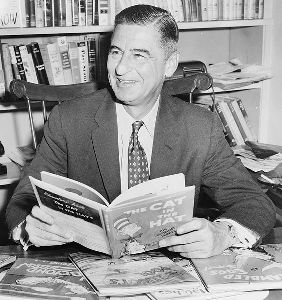
Theodor Seuss Geisel was born in Springfield, Massachusetts on March 2, 1904. He was the second child of a successful German-American family. His family ran a successful brewery until Prohibition closed it down and his father then worked for the city’s public park system. He had, by all accounts, a relatively happy childhood, attending the local Lutheran Church and selling war bonds for the Boy Scouts during WWI. He was the brunt of instances of anti-German bullying (especially during WWI) which impacted his work greatly.
After he graduated from the local high school, he attended Dartmouth College, graduating in 1925. He spent a great deal of his time writing for the college’s humor magazine. While the editor of the magazine he was caught in his room drinking bootleg gin (it was prohibition after all!) and was banned from further involvement in the magazine. In order to continue writing for the magazine, he needed an alias, and he used his middle name. It was then that “Seuss” was created. He added the “Dr.” part later in his writing career.
Thinking that he might want to become a literature professor, he left to study at Oxford. While there he spent more time traveling and doodling then studying and decided the academic life was not for him. While there he met his first wife, Helen Palmer and he decided to try to make a living as an artist. He moved to New York with Helen and started writing (and illustrating) for Judge and the Saturday Evening Post. One of the cartoons he created included Flit (a popular insecticide) which caught the eye of Standard Oil who hired him to write (and draw) advertisements for them. This led to a long career as an advertising artist for several companies. This salary also gave him the opportunity to travel and write.
In the late 30s, Geisel began writing children’s books. The first published was And to Think I Saw it on Mulberry Street (Geisel said the book was rejected 27 times) and he continued to write children’s books until it looked as if war loomed for America. Geisel found he could no longer write books for children, he needed to make America aware of the dangers from abroad (fascism and the Axis powers) and at home (isolationism and prejudice).
From 1941 to 1943 Geisel created more than 400 political cartoons for PM Newspaper in New York—tackling such subjects as racial discrimination, the dangers of isolationism, social injustice and anti-Semitism, political machinations, the war effort, and political leadership. In 1943 he joined the Army and worked for the Information and Education Division where he created the character Private Snafu-who taught by negative example. He also wrote “Your job in Germany,” a propaganda film about peace in Germany and “Design for Death,” a movie study of Japanese culture.
After the war, Geisel returned to writing children’s books and produced some of his most famous and beloved titles—The Cat in the Hat, Horton Hears a Who!, The Grinch Stole Christmas and many others. His books continued to teach important lessons and touch on important social issues. He lived in La Jolla, California after the war with his second wife and died on September 24, 1991.
Political Cartoons: An Introduction
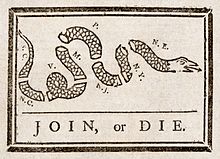
Political cartoons (also known as editorial cartoons) are defined as illustrations or comic strips containing a political or social message that usually relates to current events or personalities.
Cartoonists use specific devises to get their message across:
Symbols (simple pictures that are understood to stand in for ideas or groups). Examples: Dove/Peace, Donkey/Democratic Party
Caricatures (drawing of a person that exaggerates his characteristics for comic effect). Examples: Big ears, extra long nose
Stereotypes (generalization, usually exaggerated or oversimplified and often offensive, that is used to describe or distinguish a group). Examples: Dishonest lawyers, Italian gangsters
Analogies (comparisons—this thing is like the other thing). Examples: a situation is compared to a well known event, book, myth
Juxtaposition (positioning people or things side by side). Example: putting a politician next to a $ sign
Irony (use of words to convey a meaning that is the opposite of its literal meaning, an outcome of events contrary to what was expected). Example: when someone says it is “beautiful” when they mean ugly or “as clear as mud”
Captioning and labels (used for clarity and emphasis). Example: words at the bottom or top of cartoon to further its message
According to Charles Press, author of Political Cartooning, in order for a political cartoon to be effective it must have the following four qualities:
- Artistic quality—but the artistry must not get in the way of the message
- Genuine sentiment—but it should not feel phony
- Fresh, uncomplicated imagery—should be striking, forceful, and amusing
- Lasting importance—the subject of the cartoon should be important so the cartoon can be understood by future readers
Political (or editorial) cartooning began in America with Benjamin Franklin’s “Join or Die.” The image was created to emphasize the importance of colonial unity and reflected the well known superstition about snakes coming back to life after being cut in half.
In the 18th and 19th Centuries political cartoons were commonly independent of other writing and were used to get messages across to those who could not read. Thomas Nast, considered to be the father of political cartoons, made a name for himself with his famous cartoons of William “Boss” Tweed and the Tammany Hall scandal.
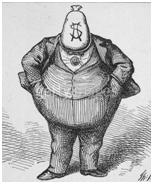
Today, political cartoons can be found in newspapers, magazines, on opinion and cartoon pages— practically everywhere you look. Political cartoons have, according to the 2007 documentary The Political Dr. Seuss, “taken their place on the page and screen as valid outlets for expressing political thought, championing activism and affecting social change through creative use of visual art.”
Cartoon Gallery:
Questions to Discuss
Directions: Choose one of the featured cartoons and answer the following questions. Keep in mind the qualities needed for an effective cartoon and the commonly used devises discussed in the Political Cartoons page.
1. What is the main message of the cartoon?
2. What event, issue or person does the cartoon refer to or target?
3. Is the cartoon trying to persuade or inform? Is so, what and how?
4. What reaction or impact is Geisel looking for?
5. What devises are used to get this message across?
6. Choose one of these devises and discuss it in detail.
7. How has Geisel drawn the people/animals? Are they distorted or exaggerated? How does this affect the impact of the cartoon?
8. Is the cartoon effective? Why or why not?
9. What would make this cartoon more effective?
10. Do you think cartoons are a good way of communicating a social or political message? Why or why not?
Download a printable pdf version of this lesson plan
TAKE ACTION:


EDUCATION PROJECTS:
Student Travel – WWII Educational Tours
High school and college students, learn the leadership principles that helped win WWII on a trip to France or during a weeklong residential program in New Orleans. College credit is available, and space is limited.
See You Next Year! HS Yearbooks from WWII
Collected from across the United States, the words and pictures of these yearbooks present a new opportunity to experience the many challenges, setbacks and triumphs of the war through the eyes of America’s youth.
The Victory Gardens of WWII
Visit the Classroom Victory Garden Project website to learn about food production during WWII, find lesson plans and activities for elementary students, get tips for starting your own garden and try out simple Victory Garden recipes!
The Science and Technology of WWII
Visit our new interactive website to learn about wartime technical and scientific advances that forever changed our world. Incorporates STEM principles to use in the classroom.
Kids Corner: Fun and Games!
Make your own propaganda posters, test your memory, solve puzzles and more! Learn about World War II and have fun at the same time.


